1998 CHEVROLET PRIZM coolant temperature
[x] Cancel search: coolant temperaturePage 127 of 364

Downloaded from www.Manualslib.com manuals search engine Engine Coolant Temperature Gage Malfunction Indicator Lamp
(Check Engine Light)
TEMP
Standard Cluster Optional Cluster
This gage shows the engine coolant temperature. If the
gage pointer moves into the red area, your engine is too
hot! It means that your engine coolant has overheated.
If you have been operating your vehicle under normal
driving conditions, you should pull off the road, stop
your vehicle and
turn off the engine as soon as possible.
In “Problems on the Road,” this manual shows what to
do. See “Engine Overheating” in the Index.
~~ -~
tis
~~ Your vehicle is equipped
with a computer which
monitors operation of the
fuel, ignition and emission
control systems.
CHECK
This system is called OBD I1 (On-Board
Diagnostics-Second Generation) and
is intended to
assure that emissions are at acceptable levels for the
life
of the vehicle, helping to produce a cleaner
environment. The CHECK ENGINE light comes on to
indicate that there is a problem and service is required.
Malfunctions often will be indicated by the system
before any problem is apparent. This may prevent more
serious damage to your vehicle. This system
is also
designed to assist your service technician in correctly
diagnosing any malfunction.
2-49
Page 204 of 364
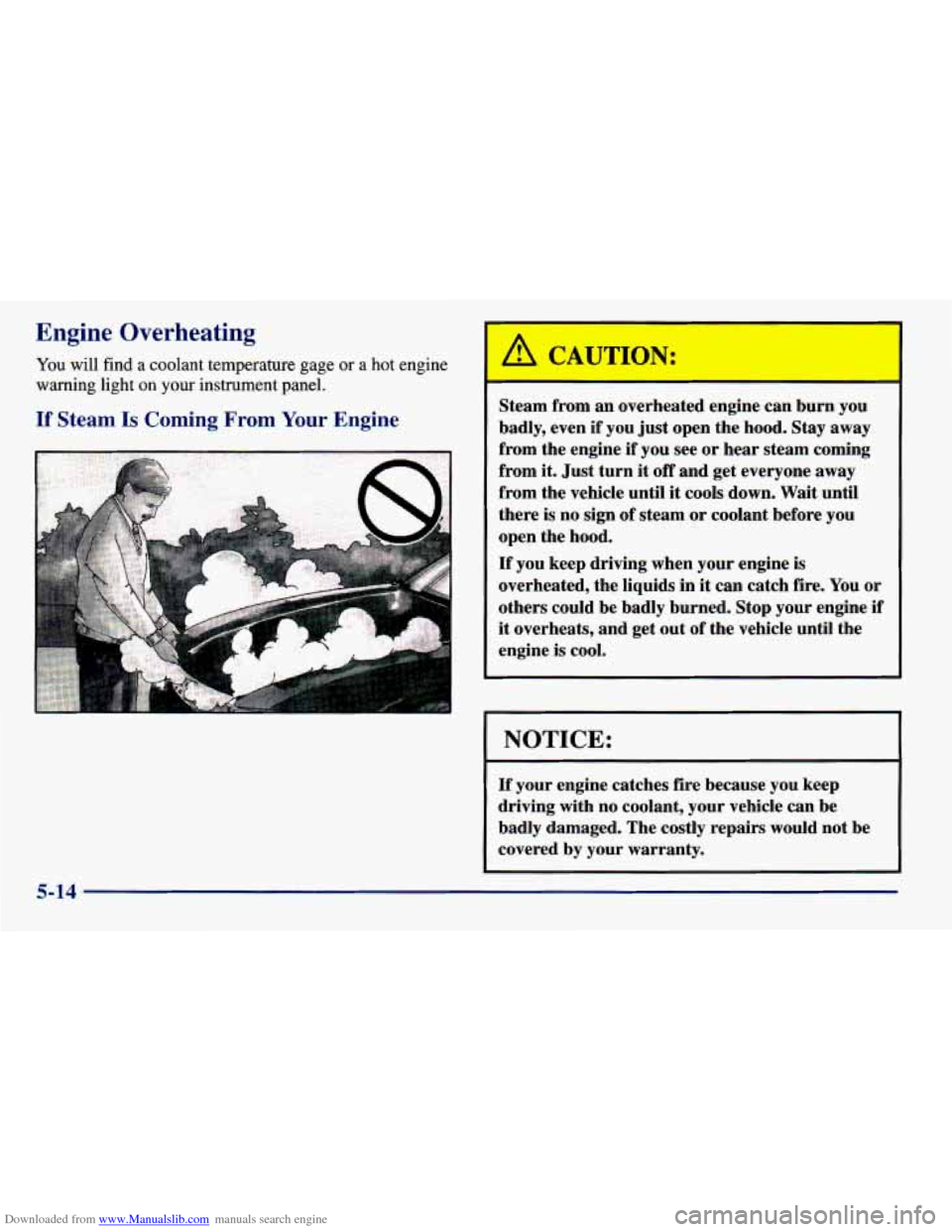
Downloaded from www.Manualslib.com manuals search engine Engine Overheating
You will find a coolant temperature gage or a hot engine
warning light on your instrument panel.
If Steam Is Coming From Your Engine
Steam from an overheated engine can burn you
badly, even
if you just open the hood. Stay away
from the engine if you see or hear steam coming
from it. Just turn
it off and get everyone away
from the vehicle until it cools down. Wait until
there is no sign
of steam or coolant before you
open the hood.
If you keep driving when your engine
is
overheated, the liquids in it can catch fire. You or
others could be badly burned. Stop your engine if
it overheats, and get out of the vehicle until the
engine is cool.
I NOTICE: I
If your engine catches fire because you keep
driving with no coolant, your vehicle can be
badly damaged. The costly repairs would not be
covered by your warranty.
5-14
Page 245 of 364
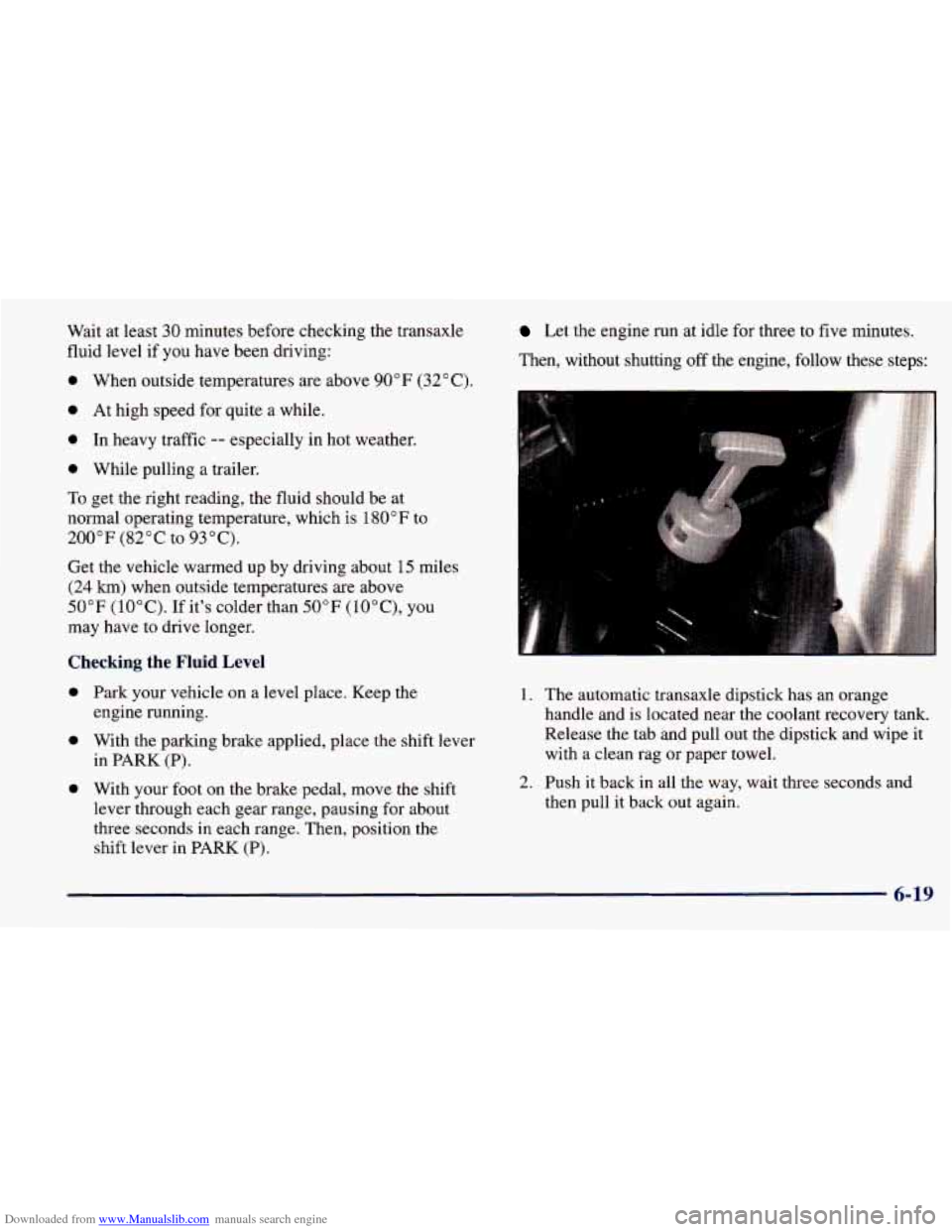
Downloaded from www.Manualslib.com manuals search engine Wait at least 30 minutes before checking the transaxle
fluid level if you have been driving:
0 When outside temperatures are above 90°F (32°C).
0 At high speed for quite a while.
0 In heavy traffic -- especially in hot weather.
0 While pulling a trailer.
To get the right reading, the fluid should be at
normal operating temperature, which is
180°F to
200°F (82°C to 93°C).
Get the vehicle warmed up by driving about 15 miles
(24 km) when outside temperatures are above
50°F (10°C). If it's colder than 50°F ( 10°C), you
may have to drive longer.
Checking the Fluid Level
0 Park your vehicle on a level place. Keep the
0 With the parking brake applied, place the shift lever
0 With your foot on the brake pedal, move the shift
lever through each gear range, pausing for about
three seconds
in each range. Then, position the
shift lever
in PARK (P).
engine running.
in PARK (P)
.
Let the engine run at idle for three to five minutes.
Then, without shutting
off the engine, follow these steps:
1. The automatic transaxle dipstick has an orange
handle and
is located near the coolant recovery tank.
Release the tab and pull
out the dipstick and wipe it
with a clean rag or paper towel.
then pull it back out again.
2. Push it back in all the way, wait three seconds and
6-19
Page 249 of 364
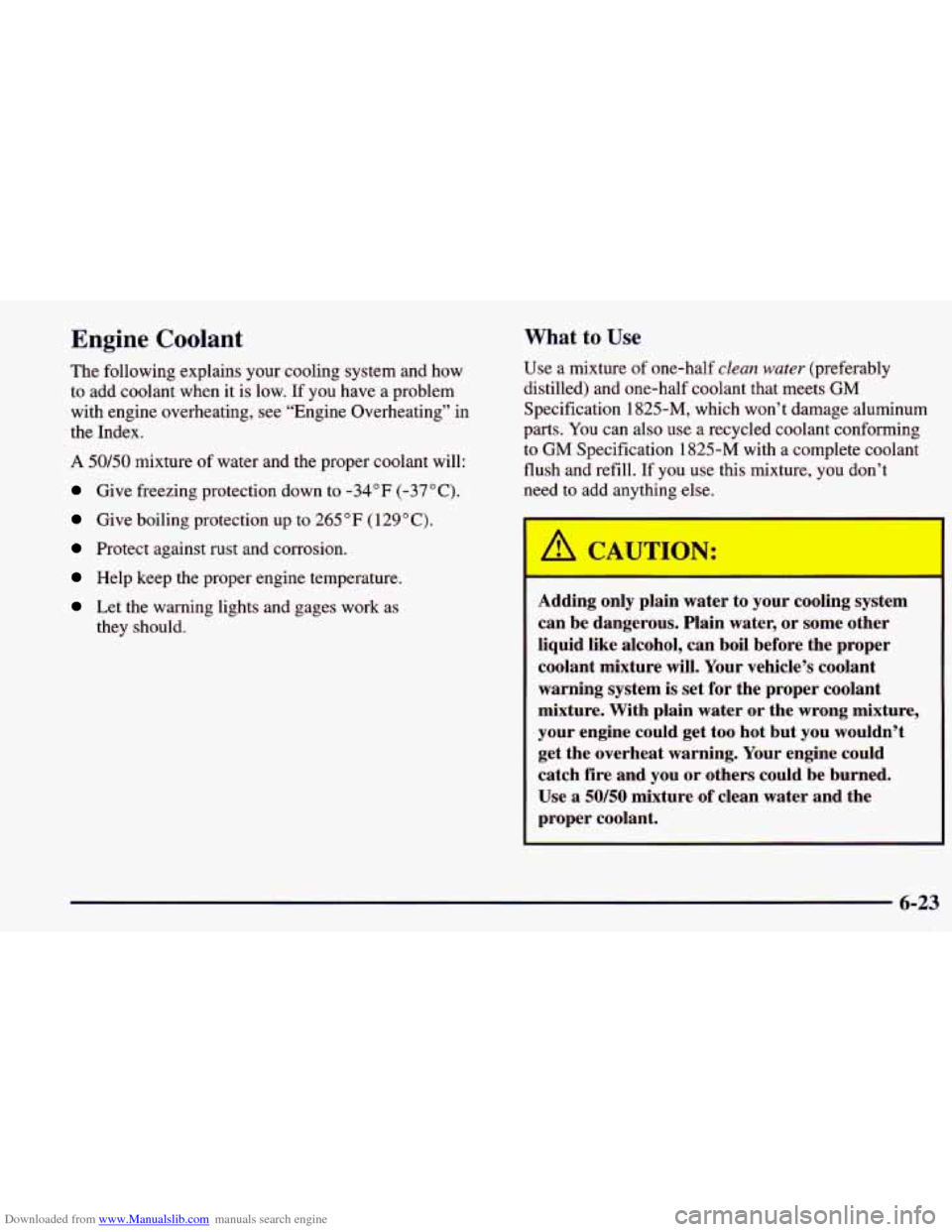
Downloaded from www.Manualslib.com manuals search engine Engine Coolant What to Use
The following explains your cooling system and how
to add coolant when it is low.
If you have a problem
with engine overheating, see “Engine Overheating” in
the Index.
A 50/50 mixture of water and the proper coolant will:
Give freezing protection down to -34°F (-37°C).
Give boiling protection up to 265°F (129°C).
Protect against rust and corrosion.
Help keep the proper engine temperature.
Let the warning lights and gages work as
they should. Use
a mixture of one-half
clean water (preferably
distilled) and one-half coolant that meets
GM
Specification 1825-M, which won’t damage aluminum
parts.
You can also use a recycled coolant conforming
to
GM Specification 1825-M with a complete coolant
flush and refill. If you use this mixture, you don’t
need to add anything else.
IC ION:
Adding only plain water to your cooling system
can be dangerous. Plain water, or some other
liquid like alcohol, can boil before the proper
coolant mixture will. Your vehicle’s coolant
warning system is set for the proper coolant
mixture.
With plain water or the wrong mixture,
your engine could get too hot but you wouldn’t
get the overheat warning. Your engine could
catch fire and you or others could be burned.
Use a
50/50 mixture of clean water and the
proper coolant.
6-23
Page 251 of 364
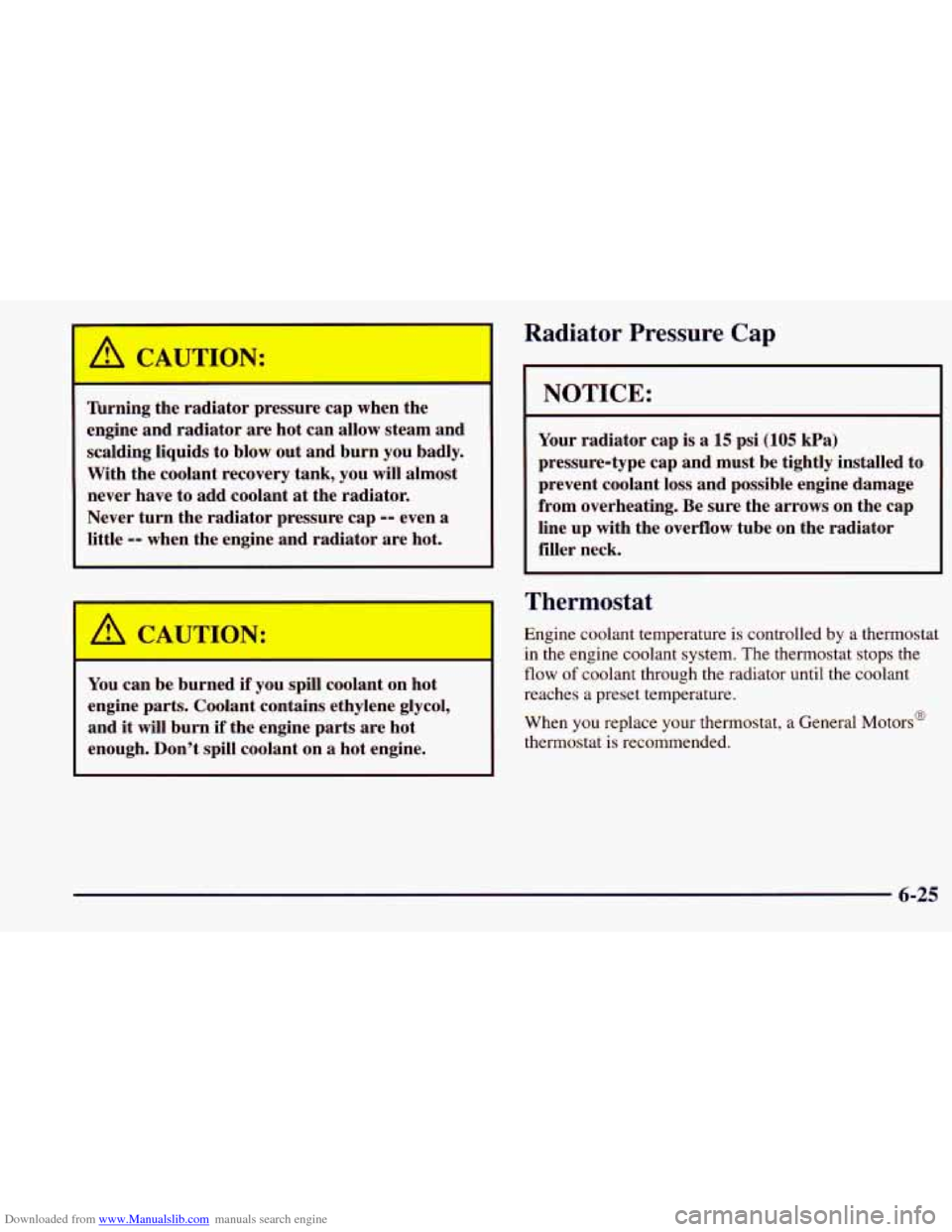
Downloaded from www.Manualslib.com manuals search engine Radiator Pressure Cap
Wrning the radiator pressure cap when the
engine and radiator are hot can allow steam and
scalding liquids to blow out and burn you badly.
With the coolant recovery tank, you will almost
never have to add coolant
at the radiator.
Never turn the radiator pressure cap
-- even a
little -- when the engine and radiator are hot.
A CAUTION:
d if you spill coolant on hot
engine parts. Coolant contains ethylene glycol,
and it will burn if the engine parts are hot
enough. Don’t spill coolant on
a hot engine.
I NOTICE:
Your radiator cap is a 15 psi (105 kPa)
pressure-type cap and must be tightly installed to
prevent coolant loss and possible engine damage
from overheating. Be sure the arrows on the cap
line up with the overflow tube on the radiator
filler neck.
Thermostat
Engine coolant temperature is controlled by a thermostat
in the engine coolant system. The thermostat stops the
flow of coolant through the radiator until the coolant
reaches a preset temperature.
When you replace your thermostat, a General Motors@
thermostat is recommended.
6-25
Page 299 of 364

Downloaded from www.Manualslib.com manuals search engine Short TripKity Maintenance Schedule
Rotate tires. See “Tire Inspection and Rotation” in the Index for proper
0 Drain, flush and refill cooling system (or every 24 months, whichever occurs
rotation pattern and additional information. (See
footnote
+.)
first). See “Engine Coolant” in the Index for what to use. Inspect hoses. Clean
radiator, condenser, pressure cap and neck. Pressure test cooling system and
pressure cap.
An Emission Control Sewice. (See footnote “f)
0 Change manual transaxle fluid every 30,000 miles (50 000 km) only if your
vehicle is used to tow a trailer.
0 Change automatic transaxle and differential fluid every 15,000 miles
(25 000 km) if the vehicle is mainly driven under one or more of
these conditions:
- In heavy city traffic where the outside temperature regularly reaches
- In hilly or mountainous terrain.
- When doing frequent trailer towing.
- Uses such as found in taxi, police or delivery service.
90°F (32°C) or higher.
If you do not use your vehicle under any of these conditions, check the fluid.
7-13
Page 310 of 364
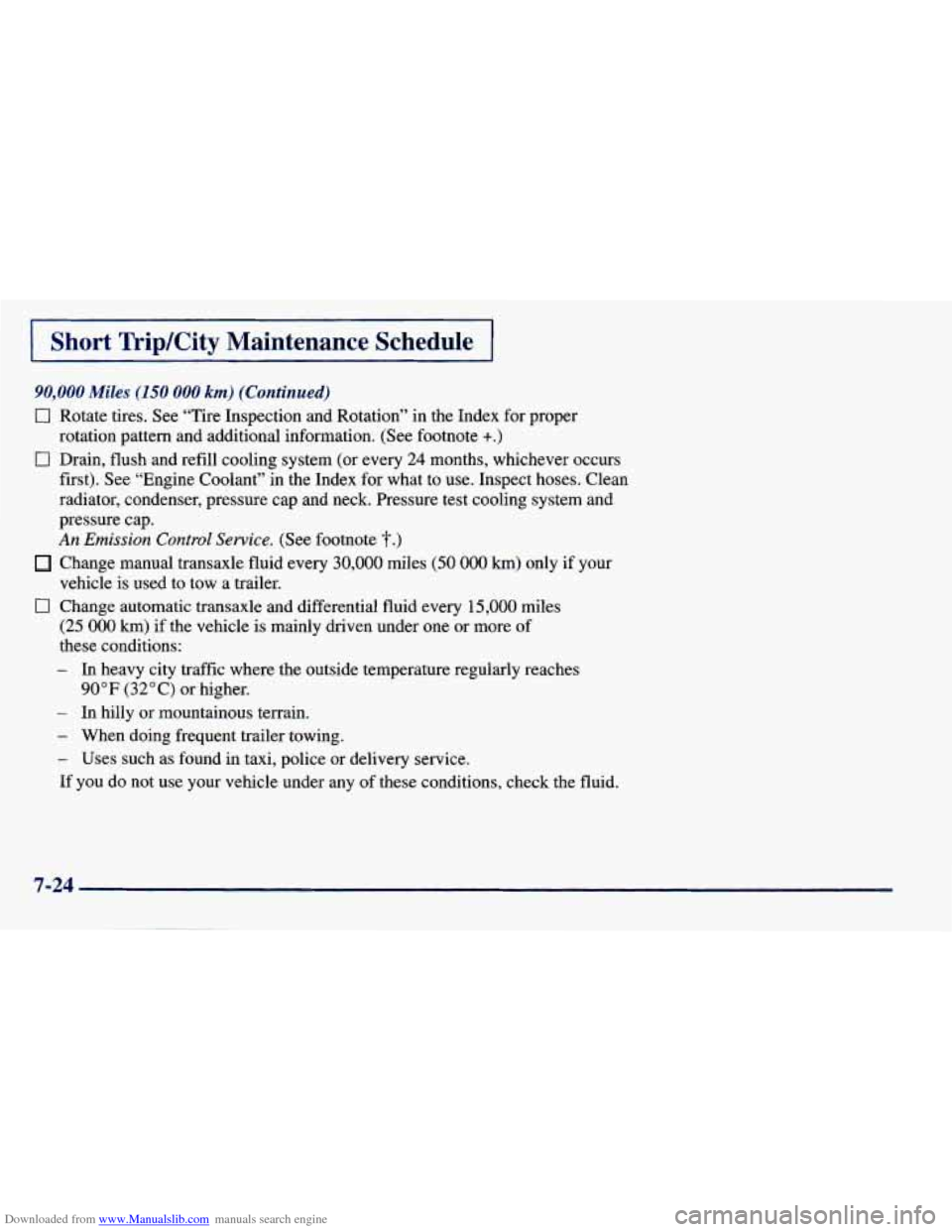
Downloaded from www.Manualslib.com manuals search engine I Short TripKity Maintenance Schedule I
90,000 Miles (150 000 km) (Continued)
0 Rotate tires. See “Tire Inspection and Rotation” in the Index for proper
0 Drain, flush and refill cooling system (or every 24 months, whichever occurs
rotation pattern and additional information. (See footnote
+.)
first). See
“Engine Coolant’’ in the Index for what to use. Inspec\
t hoses. Clean
radiator, condenser, pressure cap and neck. Pressure test cooling system and
pressure cap.
An Emission Control Sewice. (See footnote “f)
Change manual transaxle fluid every 30,000 miles (50 000 km) only if your
vehicle
is used to tow a trailer.
0 Change automatic transaxle and differential fluid every 15,000 miles
(25 000 km) if the vehicle is mainly driven under one or more of
these conditions:
- In heavy city traffic where the outside temperature regularly reaches
90 OF (32 O C) or higher.
- In hilly or mountainous terrain.
- When doing frequent trailer towing.
- Uses such as found in taxi, police or delivery service.
If you do not use your vehicle under any of these conditions, check the \
fluid.
7-24
Page 315 of 364
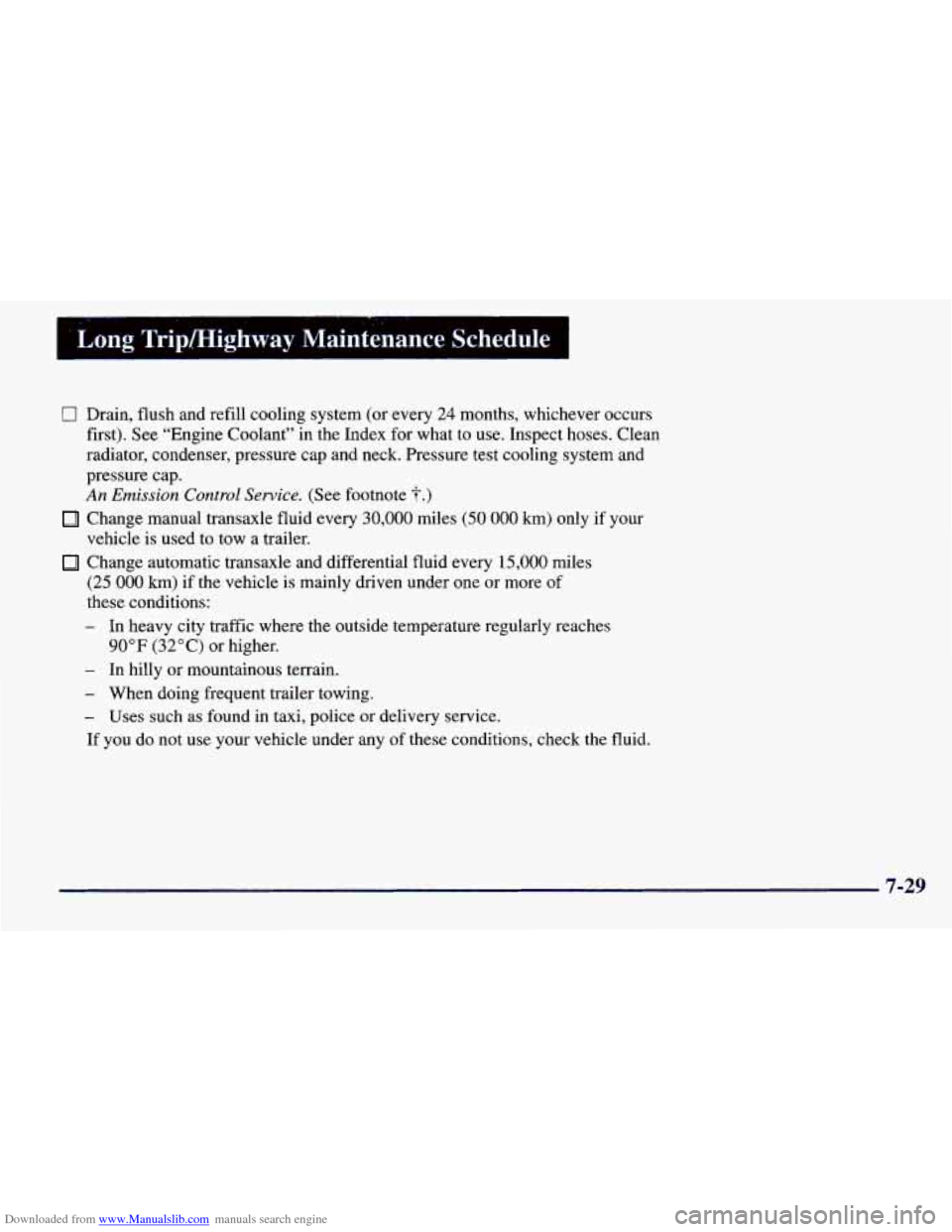
Downloaded from www.Manualslib.com manuals search engine I Long Tripmighway .Maintenance Schedule
0 Drain, flush and refill cooling system (or every 24 months, whichever occurs
first). See “Engine Coolant’’ in the Index
for what to use. Inspect hoses. Clean
radiator, condenser, pressure cap and neck. Pressure test cooling system and
pressure cap.
An Emission Control Service. (See footnote T.)
Change manual transaxle fluid every 30,000 miles (50 000 km) only if your
vehicle is used to tow a trailer.
Change automatic transaxle and differential fluid every 15,000 miles
(25 000 km) if the vehicle is mainly driven under one or more of
these conditions:
- In heavy city traffic where the outside temperature regularly r\
eaches
90°F (32°C) or higher.
- In hilly or mountainous terrain.
- When doing frequent trailer towing.
- Uses such as found in taxi, police or delivery service.
If you do not use your vehicle under any of these conditions, check the fluid.
7-29